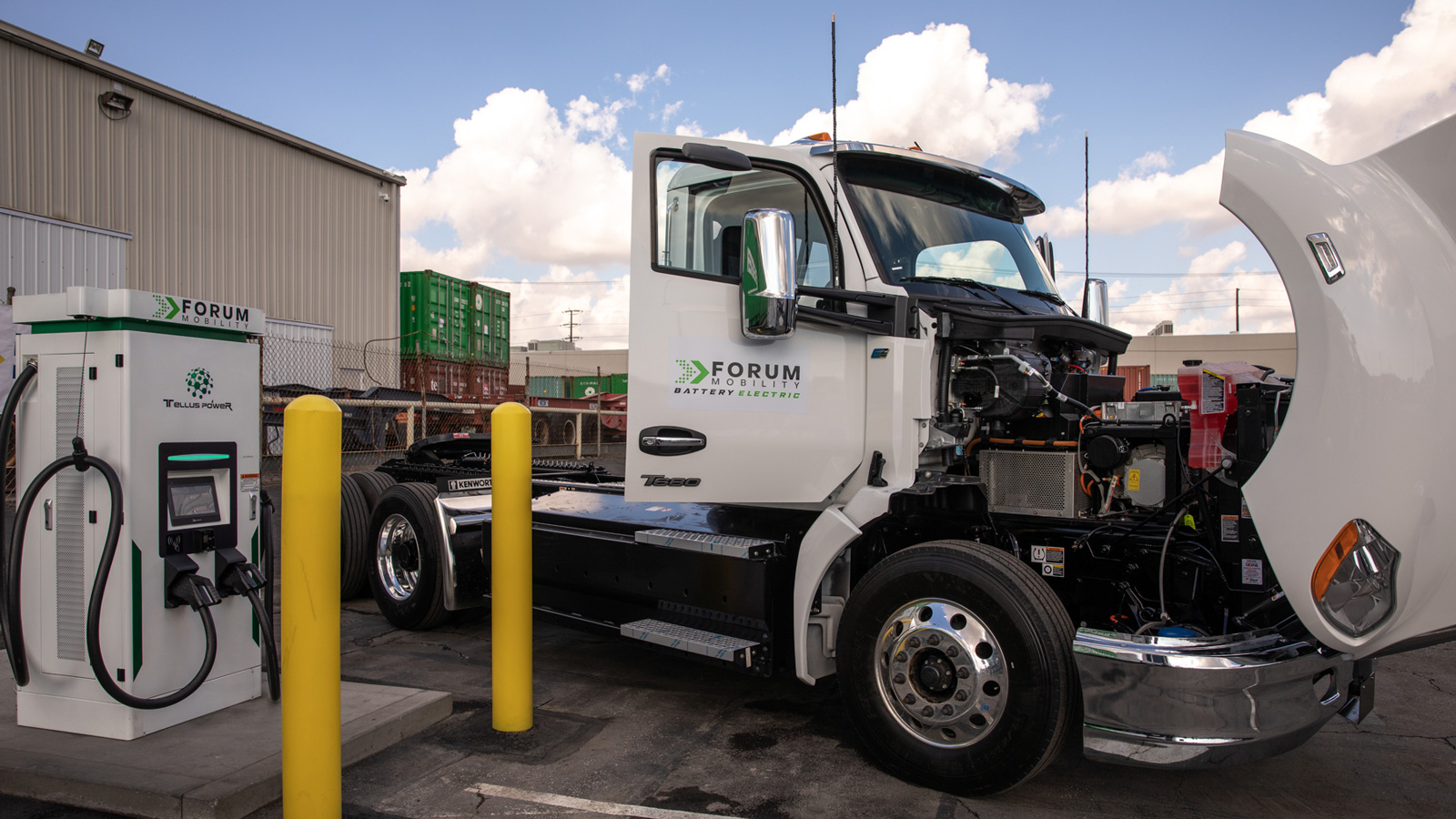Dealing with the malfunctioning hardware, long lines, and slow speeds that too often plague public charging infrastructure can be a nuisance for EV drivers. But for truckers and fleet operators, hassles like these would jeopardize their ability to earn a living.
Providing a smooth, predictable charging experience will be essential if California is to meet its ambitious goal of decarbonizing the 30,0000 drayage trucks that serve the state’s ports and railyards by 2035. Fourteen other states also have pledged to electrify trucking, and the biggest impediment to achieving that remains building a robust charging infrastructure.
It’s an ambitious goal that California estimates will require 157,000 chargers statewide by 2030. But much like electric car owners, fleet operators don’t always have the space or resources to install their own charging hardware. Some will need an entirely new type of charging network.
A handful of companies are rushing to address this challenge by building networks of electric truck depots where multiple fleets can reliably access the charging they need precisely when they need it. Oakland startup Forum Mobility announced Tuesday it will begin building an expansive depot near the Port of Oakland, the first in Northern California.
The Greenville Community Charging Depot will be able to fast-charge 96 trucks simultaneously. It will be built on more than four acres of land along Interstate 580 in Livermore, a corridor used by most of the 5,000 trucks that regularly move in and out of the Port of Oakland.
“For heavy-duty trucks, which can’t access 99.9 percent of the chargers installed today, having a purpose-built facility like this one gives people the certainty that they can get their truck charged every single day,” said company CEO Matt LeDucq.
Trucks that carry containers to and from ports, a form of trucking called drayage, are a great place to begin decarbonizing heavy-duty vehicles. They typically follow fixed routes, and return to centralized locations where they can be charged after each shift. Electric rigs can take anywhere from three to 10 hours to charge depending on the speed of the charger.
The Livermore depot will offer what the industry calls “charging as a service,” in which subscribing fleets can reserve spots to ensure that they can power up between shifts, typically overnight but also between runs. Forum will also offer fleets the option of leasing electric trucks, or “trucks as a service.”
“These providers are a really important part of making the electric- truck cost of ownership superiority available to more truck operators,” said Ari Kahn, carbon-free transportation manager at RMI. “They create an ability to own and operate electric trucks for fleets that might not have charging in their facility, and they also make trucks accessible to small fleets and individual operators who can’t take on the financing for the trucks themselves.”

The announcement comes two months after California released the Advanced Clean Fleets rule, a first-in-the-nation regulation that will catapult the truck industry toward electrification. The rule requires that any new truck added to the state’s drayage registry beginning on Jan. 1, 2024, must be zero emission, and that all drayage trucks entering seaports and railyards be zero emission by 2035.
Medium and heavy-duty vehicles are responsible for one-fifth of greenhouse gas emissions in California, and the state estimates that by 2050, the regulation will reduce nitrous oxide emissions by 146,000 tons and carbon dioxide pollution by 327 million metric tons.
Critics of the rule argue that although its objectives are important, the timeline is unrealistic for one key reason: a lack of charging infrastructure. Based on the California Energy Commission estimates of how many chargers are needed by 2030, about 60 chargers would need to be installed every day for the next seven years.
“This is a historic measure, but unfortunately the regulation is more aspirational than reality based,” Matt Schrap, CEO of the Harbor Trucking Association, said in a statement after the rule was announced. “There are plenty of providers out there trying to come up with solutions to help fleets transition, but no one can say with a straight face that we are ready for a mandate that begins in less than 8 months.”
Indeed, there are currently only two multi-fleet truck charging depots operating in the state. Last year, Zeem Solutions opened one outside Los Angeles International Airport with 77 fast chargers and 53 conventional chargers for trucks, vans and shuttle buses. Last month, WattEV opened a 26-truck charging plaza at the Port of Long Beach.
One of the largest barriers to building the infrastructure needed is finding sites with sufficient power capacity or a utility willing and able to make the upgrades.
“Finding sites that have a lot of power, are zoned correctly, and are on major trade corridors, you’re looking for those Venn diagrams to overlap pretty specifically,” said LeDucq.
That’s something East Bay Community Energy, which will provide the power for the Livermore depot, is working on. “We are very focused on trying to find more viable sites to host these big depots,” said CEO Nick Chaset.
EBCE loaned the company $4.5 million for the project and will provide 100% renewable energy for the charging stations. It is the agency’s first foray into trying to accelerate the adoption of electric trucks, but part of a larger effort to invest in decarbonizing the region’s transportation sector.
Forum Mobility is in the process of creating enough depots to serve about 600 trucks across eight sites in Northern and Southern California in the next 18 months, but LeDucq said the work won’t end there. “We’re going to need hundreds of Livermore depots to be developed over the next 10, 20 years, to serve what comes out of Advanced Clean Fleets.”
This story was originally published by Grist with the headline A planned “charging depot” reveals what powering electric big rigs could look like on Jun 13, 2023.
This post was originally published on Grist.